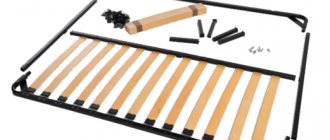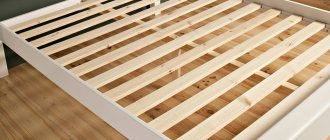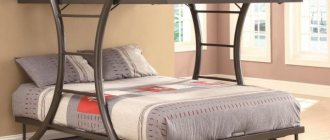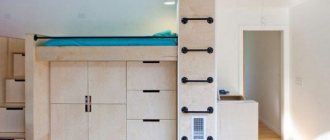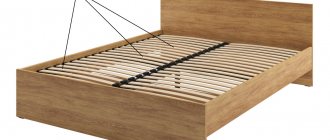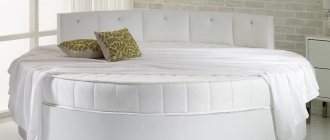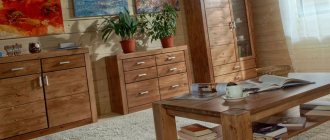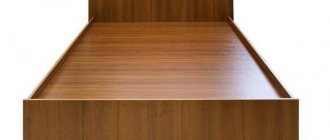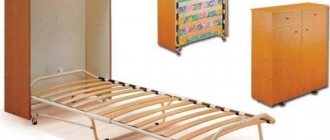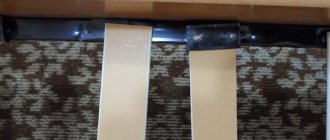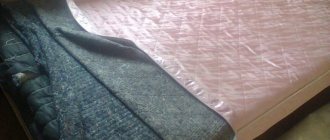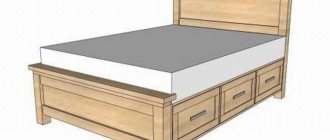Many people face this choice when it comes time to buy a bed. The question arises: why buy an orthopedic base when you can get by with an orthopedic mattress?
If you decide to improve your body's health, select a bed with an orthopedic base.
Buying a good orthopedic mattress is a profitable investment in your comfort and well-being.
In this article we will answer this question and tell you what the advantages and disadvantages of foundations are and what to look for when purchasing.
Types of bases
There are two categories of beds: flat solid and orthopedic lattice.
1) Flat solid is a surface made of planed boards, plywood or chipboard (made from pressed wood chips). It is treated with protective and decorative agents and attached to the frame. A solid base is heavier than an orthopedic one and is less mobile. And most importantly, it prevents the mattress from revealing all its orthopedic characteristics and capabilities. Thus, sleep worsens.
Such a base interacts worse with the mattress due to poor ventilation, therefore its service life is reduced.
2) An orthopedic lattice base for a bed consists of a metal or wooden frame with a lifting mechanism and legs, wooden slats, which are attached to it using lath holders.
Lamels are curved wooden planks.
Lamels can be made from the following types of wood:
- Birch;
- Beech;
- Nut.
Birch slats are the optimal material. They perform their functions adequately and at the same time are cheaper than slats made from other types of wood.
Walnut and beech slats are more expensive, but they are durable and can withstand more weight.
Standard lamella sizes:
- Thickness from 6 to 8 mm;
- Optimal width 63 mm;
- Length according to the dimensions of the base;
- The distance between the lamellas is 70-80 mm, this distance allows to improve the orthopedic effect;
- The optimal number of lamellas is from 11 to 13 pcs.
The slats provide a comfortable and anatomically correct position of the body.
These sizes of slats allow you to make the bed lighter. They give it elasticity and harmonious interaction with the orthopedic mattress, which allows you to achieve maximum comfort.
The lamella grid can withstand loads of up to 150 kg.
All orthopedic bases undergo all mandatory strength tests.
Criterias of choice
When purchasing furniture, it is important to take into account not only the height of the users, but also the size of the room. The age of the people who will sleep on it is also of great importance. As for the length of the furniture, it should exceed the user’s height by 15–20 cm.
Modern bunk beds made of solid wood in the interior of a nursery
It is important to consider the following factors:
- The density of the lamellas in the base is selected depending on the expected load. You need to take into account not only your own weight, but also the weight of bedding, including the mattress, as well as children who like to run into their parents’ bed in the morning.
- Soft mattresses are suitable for daily use by older people who like to sleep on their sides. Products of medium hardness are recommended for people of average height and weight who lead an active lifestyle. Hard mattresses are suitable for children and adolescents whose musculoskeletal system is not yet fully developed, users with back pain and those who are overweight.
- The base area at the head can be soft or hard depending on consumer preferences.
- A fragile, cheap frame will quickly damage the entire structure. The best option in terms of cost and quality is a metal base. For fixed beds for home use, a steel item is recommended; for folding beds, an aluminum item is recommended.
- If the mattress is selected separately, it is important that it fits the base in size, does not bulge, or slide during use.
The presence of a niche for things under the base, with all its convenience, eliminates one of the important advantages of a bed with an orthopedic mattress - good ventilation. In this case, the base must be systematically raised so that all internal compartments are ventilated.
Choosing a good orthopedic bed, which will provide comfortable conditions for rest and sleep for many years, while simultaneously providing unobtrusive prevention of diseases of the musculoskeletal system, is quite a troublesome matter. You need to take into account many nuances, comparing your desires with material capabilities. It should also be remembered that purchasing an orthopedic bed is not only a renovation of the interior, but also an investment in preserving the health of yourself and your loved ones.
Slat density
Mattress hardness
Frame strength
Availability of storage space
Design features of a bed with an orthopedic base
In addition to the listed advantages, this design allows the bed to be more mobile, which will significantly save space in the car when moving and make unloading and loading easier.
This option is well suited for rented apartments, motels, and hotels.
Sleeping structures with such bases can be disassembled and assembled without much effort; the following elements are separated from the frame:
- Sleeping area;
- Legs;
- Upper base with slats;
- Lower part, with drawers for linen.
The disassembled structure can be transported by car.
Such designs are equipped with a lifting mechanism and have the ability to compactly store things and bedding. The legs are detached, the slats are pulled out of the lath holders, leaving a metal frame with a mattress.
All other parts of the structure are compactly folded into a box.
The designs are available in 2 types:
1) Without stiffness adjustment;
Bed base without the ability to change the rigidity of the slats.
2) With adjustable rigidity (a very important, at the same time convenient function for double designs).
This feature is convenient for a bed on which people of different weights sleep.
Using the adjustment, you can adjust the rigidity of the orthopedic base, individually for each person lying on it. There are 7 hardness zone points:
- Head,
- Shoulders,
- Back,
- Taz,
- Hips,
- Knees,
- Feet.
A bed with the ability to adjust the rigidity of the slats along their entire length.
Towards the base of the bed, it is important to choose the right mattress. Orthopedic mattresses are made with different fillings. These are mainly springs, horsehair, coconut coir, and natural latex.
All these fillers do not cause an allergic reaction, are well ventilated and moderately elastic, which creates the maximum effect for a comfortable sleep.
Dimensions
The length of the base should be 20 cm greater than a person’s height, the width of a single base should be at least 80 cm. Such dimensions allow you to sit comfortably on the bed.
A bed with such dimensions does not take up extra space in the room.
The legs are made of high-strength metal, the most convenient length of the legs is 24-25 cm. The height of the base depends on them. The stability of the structure is ensured by the number of legs (there are up to 7 of them on the frame).
To strengthen the structure, a central frame runs through the middle.
The total height is 27-28 cm, it all depends on the manufacturer. The lamella grid serves to properly distribute weight on the mattress and extend the life of the mattress.
Choosing an orthopedic base
When choosing, you need to pay attention to the following factors:
- The quality of the lamellas (they should not have large knots or cracks);
- The base should not creak; creaking causes discomfort;
- The metal frame should not have rust, chips or scratches;
- Wooden bases should not have loose mounting holes or sharp untreated edges;
- Completeness of accessories;
- The slats should not be chipped;
An important criterion is the brand of the product, since sleep comfort and the service life of the orthopedic base depend on the quality of the product.
The mounting details of the slats affect the price and quality of the bed. The slats are attached to the base using lath holders.
Lat holders are fasteners designed to hold slats in a sleeping structure.
The slats are attached with the convex side up. They come in rubber and plastic. Rubber ones are more elastic and expensive.
Plastic lathe holders are cheaper, but more rigid and durable than rubber ones.
Orthopedic bases are produced with a lifting mechanism. Mechanisms are divided into several types.
- The manual mechanism is reliable and has a longer service life than all others, but is inconvenient, because when opening it you have to hold the base and the mattress at the same time.
- It is spring-loaded, difficult to lift, but does its job well; over time it has to be replaced due to the fact that the springs stretch.
- Gas springs open smoothly and silently and are mainly used to lift heavy bed structures.
- The lifting mechanism is electrically driven - it is convenient to use and is driven by a control panel.
Beds with a lifting mechanism can be equipped with drawers for linen, thereby saving space in the bedroom.
The legs are made of high-strength metal, have a comfortable height, are easily detached and attached to the bed frame, and provide stability to the entire structure and additional mobility of the bed.
How to choose?
Today, Moscow stores offer a variety of types of frames. However, whatever model is required, the choice of bed base should be based on the following criteria:
- Type of mattress. Wide-lamella ones are suitable for springless models and products of high rigidity, narrow-lamella ones for all others.
- Sleeping together or alone. In the first case, it makes sense to think about purchasing one with a slat adjustment system.
- Own weight. The higher the body weight, the stiffer the base should be - and the smaller the distance between the lamellas.
- Workmanship. Signs of a good foundation are even and smooth lamellas without irregularities or cracks, a frame without signs of rust or mechanical damage, and no squeaking when pressing on the slats and frame.
If you have difficulty making a choice, do not refuse the help of specialists. Consultants will definitely help you choose an anatomical base, taking into account the dimensions of the mattress and bed, as well as the individual needs of the buyer.
Orthopedic base with adjustment
There are two types of adjustment.
1. Adjusting the rigidity of the lamellas.
This adjustment allows you to adjust the stock to your weight.
2. Adjustment of the upper and lower parts of the base.
This type of adjustment will allow you to comfortably enjoy breakfast and provide blood flow to tired legs by placing them at an angle.
Reliability and strength are not lost from such functions, since manufacturers take into account all the necessary points during testing.
Summing up
The advantages of classic beds that have a solid base are that they are designed to carry more human weight than those with an orthopedic bed frame and are more stable due to their weight.
The disadvantages of the bases of such beds are that they are more bulky, less mobile, they have a shorter mattress life, and they are more difficult to repair than beds with an orthopedic base.
Beds with an orthopedic base also have a number of advantages and disadvantages.
The advantages of such beds are much greater than the disadvantages. They are designed for a weight of up to 150 kg, light in weight, mobile, quickly disassembled and assembled. It is possible to adjust the rigidity of the berth individually. There is a wide variety of designs, a wide price range. The frame can be used independently of the bed. Beds equipped with a lifting mechanism are easy to use.
In the manufacture of such beds, modern technologies are used, which expands their capabilities and provides additional comfort.
The only disadvantage is that such beds are designed for less weight.
Characteristics of elements
All components of an orthopedic bed - base, frame, mattress - may differ in their characteristics. The correct selection of elements enhances their positive properties and makes the effect of furniture on the body more effective. The quality of the design is most important, especially if the model is purchased for a child.
How to choose and where to place a bunk bed for adults, tips
Base
The orthopedic base provides direct support for the mattress. This is a frame-mounted structure consisting of a rectangular frame, lamellas (transverse) with holders. Common canvas frame materials are wood or metal. Products made from the first raw material are lighter, but those made from the second will last longer.
In addition to the lattice (most common) base, there is also a solid one. Its advantage is its versatility - it is suitable for various types of mattresses. In addition, the cost of such products is much cheaper than other options. The canvas can be made of chipboard, fiberboard or plywood. The element is fixed in the middle of the frame due to the transverse support. Its disadvantages: it is heavy and difficult to repair the product.
For a single orthopedic bed frame, 4-5 support legs are sufficient. One-and-a-half and double beds have 5-6 legs (the fifth and sixth are located in the middle). In beds without such, the frame is attached to the base using drawers.
Lattice
Solid
The slats can be spring or straight. The former are more comfortable and softer to sleep on, but it is recommended to choose children's beds with even slats. The slats are installed in a direction transverse to the frame (if spring ones are used, then with the curved side up). Each part is fixed in separate holder grooves or on a metal frame-stand and functions autonomously.
The width of the slats is 25–120 mm, the thickness is 1–10 mm, the distance between the elements is 2–6 cm. If the bed is double, the slats are placed in two rows - separately for each sleeper. The more often they are located, the higher the weight they can withstand (up to 150 kg). The standard installation for a double base measuring 160 x 200 cm is considered to be 30 lamellas, the minimum is 22 pieces.
Depending on the width of the orthopedic bed slats, there are:
- Wide (50–70 mm) - used for springless latex mattresses and products with spring blocks. The distance between them during installation is 4–6 cm.
- Narrow (30–40 mm) - for mattresses with independent and tightly installed springs. The distance between such slats should not exceed their width.
Narrow
Wide
If the person resting on the bed weighs more than 90 kg, it is advisable to use narrow slats; for people weighing less, wide slats. Beds are easy to use in which the base, together with the mattress, rises, opening access to a niche located underneath for storing bedding. Lifting can be carried out:
- Using a manual hinge mechanism. It is the simplest and cheapest, but requires considerable physical effort. In addition, the body of inexpensive models is often made of chipboard. If you drop the base, the frame will quickly fail.
- Spring lift system. This mechanism makes the effort easier, but a child or an elderly person will not be able to cope with this work. In addition, springs last about 5 years, after which they stretch and require replacement. The device is inexpensive.
- Gas lift, or a mechanism on gas shock absorbers. Requires virtually no human effort. Fixes the raised base securely, and operates smoothly and without noise. It costs more, but the comfort of use fully compensates for these costs. Moreover, the service life is about 10 years.
- Using the remote control. In high-tech orthopedic beds equipped with an electric drive, you can adjust the height of the headboard, footboard, and other parameters. Such models are expensive and functionally similar to medical ones.
Types of bunk beds for girls, selection criteria
Orthopedic bases can be adjustable. You can change their properties in two ways:
- by rigidity: with special holders at separate intervals, the lamellas are fixed at a close distance from each other or connected two at a time in thickness, forming more rigid sections;
- according to the height of the headboard or footboard - in beds with electric drive.
Manual mechanism
Spring
Gas lift
Electric
Frame
Popular materials for the manufacture of orthopedic bed frames:
- Wood is environmentally friendly and pleasant to the touch. Strength depends on the hardness of the rock. The cost of models made from natural solid wood is high; such furniture belongs to the elite class.
- Metal is durable (lasts 20–30 years), harmless. To achieve better moisture resistance, the surface of modern models is covered with a special protective layer.
- MDF, fibreboard, chipboard - they are used to make the cheapest furniture, the least durable and often questionable from the point of view of health safety.
When choosing a bed made of chipboard, you should carefully read the certificates for the material and make sure of the quality of the edges and protective film, which partially protect against harmful fumes of chemical impregnations.
Additional comfort is provided by the height-adjustable frame due to the flexible design of the legs. Thanks to this, the bed stands without swaying or distortion even on an uneven surface, and the floor covering of any quality is protected from scratches and other damage.
Tree
Metal
MDF
Chipboard
Mattress
An orthopedic mattress can be spring or springless. The first, in turn, is divided into the following types:
- Equipped with an independent spring unit (Pocket Spring) - the spring density is about 200–1200 pieces per square meter, and each of them works autonomously. Such a device allows the mattress to best “adapt” to the anatomical features of the body and create the most comfortable conditions for rest.
- With a Bonnell spring block - with the same spring stiffness, tightly connected to each other. This system is more similar to armored mesh; its orthopedic properties are lower, but due to their lower cost, such mattresses are popular.
Springless options also come in different types:
- monoblock - based on one filler. For example, a fairly rigid sheet of coconut coir is used in children's mattresses and products for people with spinal problems.
- combined - using several materials.
In both spring and springless products, heat-pressed felt, coconut coir, natural latex, polyurethane foam, sheep wool, and cotton wool are used as raw materials to create layers. To extend the life of the mattress and help it keep its shape longer, you need to turn it once a week for the first 2-4 months of use, and then every 3-6 months.
Independent spring block
Bonnell spring block
Springless
Useful tips
If the sleeping person weighs more than 90 kg, then narrow slats should be used; wide slats are suitable for people with less weight. Some foundation manufacturers also produce mattresses. It is recommended to choose mattresses and bases from the same manufacturer.
Additionally, you can get a discount on products.
Pay attention to the complete set; some manufacturers order legs separately. To experience the full effect of an orthopedic mattress, first buy a mattress, then a base for it. If you don’t have enough money to purchase a suitable option, you can get a loan at many retail outlets, thereby making a long-term investment in your health.
An additional advantage of the orthopedic lattice is rapid repair.
To replace a broken lamella, you can always order a product of the required size, buy it in a store. Many sellers offer their customers free delivery of bases - this is another nice bonus. Sellers and manufacturers who value their reputation always meet customers halfway and exchange goods in the event of a manufacturing defect.
Remember: a high-quality, correctly made orthopedic base is the key to healthy sleep.
Anatomical bed frame - what is it?
"Anatomy of Sleep" is a magazine about stylish living in the bedroom and healthy sleep. Every day you will find an interesting story, important advice and useful interview here. Together with the authors, you will figure out how to choose mattresses and pillows from thousands of products, what accessories are ideal for the bedroom, how to assemble your own bed or sew a canopy, see the “filling” of orthopedic sleep products, and meet experts and craftsmen. The magazine "Anatomy of Sleep" is a branded media of the online store "Anatomy of Sleep". One of the largest markets of popular domestic and foreign manufacturers of mattresses, beds, furniture and sleep accessories in Russia.
Beds with orthopedic base – 50 photo ideas:
PreviousBedsHow to make a headboard with your own hands
Next
BedsFolding bed with mattress - advantages and disadvantages
